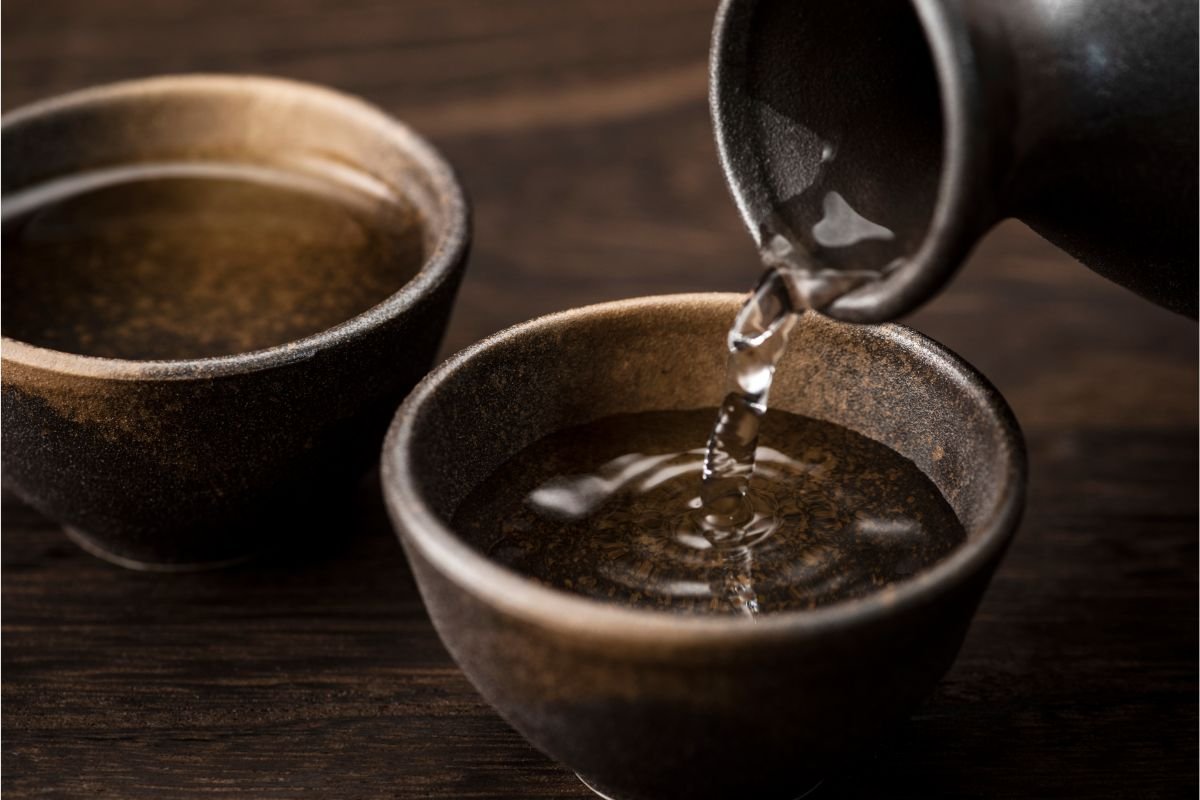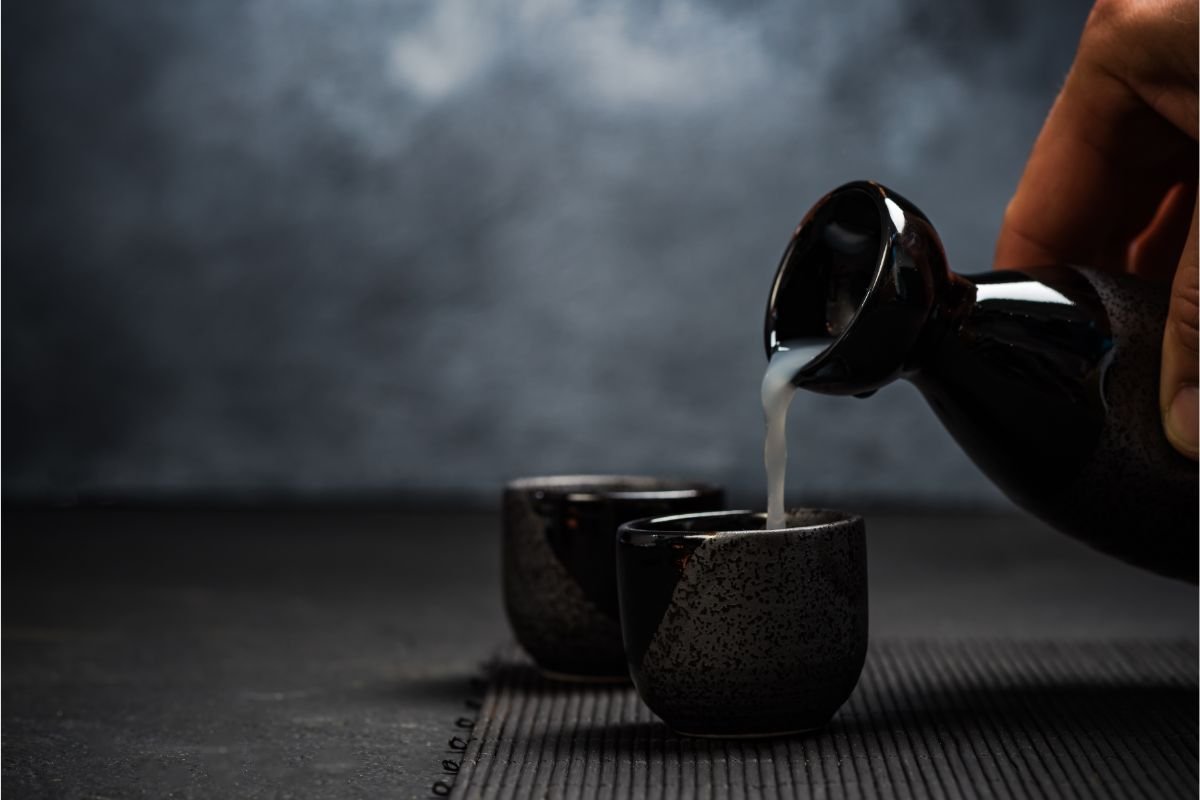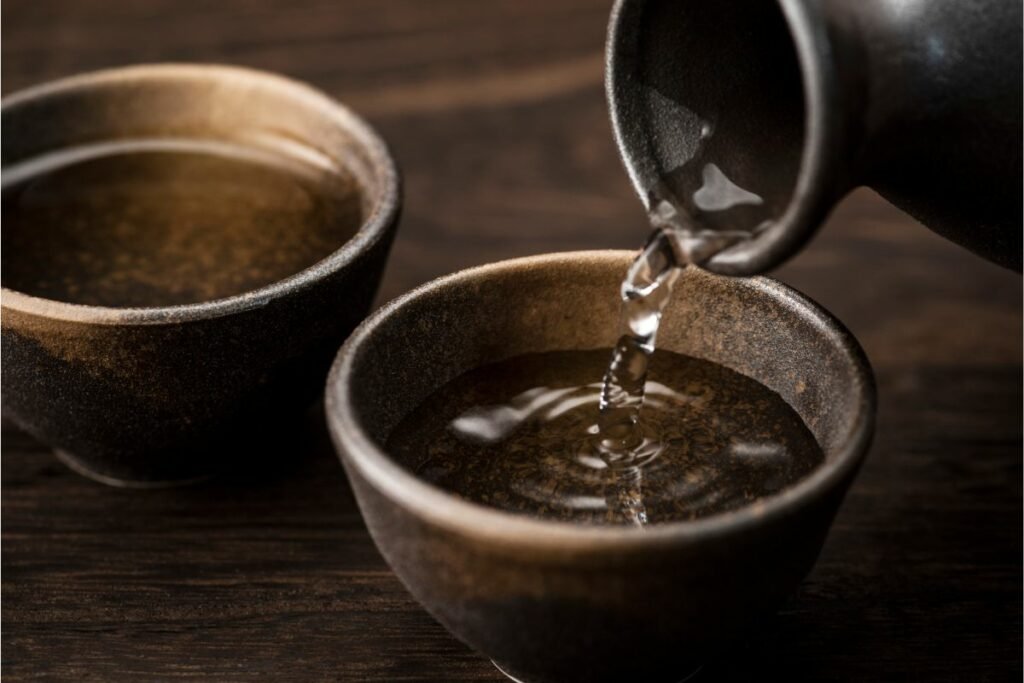Sake, a fragrant alcoholic beverage made from fermented rice, has been enjoyed in Japan for centuries. Although it’s gaining popularity worldwide, you’re most likely to enjoy sake in a Japanese restaurant, or at a party hosted by a Japanese friend.
Sake is closely tied to the culture of Japan, which is why the style of serving sake might take you by surprise. Instead of big glasses that you can fill at your leisure, sake is often served in small cups, and you aren’t expected to pour your own.

The small sake cup has both cultural significance and practical benefits. In this guide, we’ll take a look at what sake is traditionally served in, and why sake tends to be enjoyed from small cups.
What Is A Sake Set?
Order sake in a Japanese restaurant, and it’s likely to be served to you from a sake set. This traditionally consists of a flask for pouring the sake and a small cup the sake is poured into. If you visit Japan, the traditional sake set is a popular souvenir!
The sake flask is known as the tokkuri. The tokkuri traditionally has a bulbous base with a narrow neck. If you’re enjoying sake warm, it’s typically poured into the tokkuri, which is then placed in a pan of hot water.
Thanks to the narrow opening of the tokkuri, the heat stays trapped inside, even when it’s removed from the water.
The sake is then poured from the tokkuri flask into a cup, often known as an ochoko. There are a few different types of sake cups, but the ochoko is the most common. This is a very small cup, and it can be made of a variety of materials.
The ochoko might be a traditional serving cup, but if it’s your first time enjoying sake, you might wonder why you’ve been given such a tiny drink!
Types Of Sake Cups
There are several different styles of cups that sake is traditionally served from. These include:
- Ochoko. The most common type of sake cup, the ochoke is a small cup with a bowl shape. The wide rim allows the aromas of the sake to float upwards, so you get the full experience as you drink. Ochoko cups can be made from glass, wood, metal, and ceramics.
- Guinomi. The guinomi is very similar to the ochoko cup. It has a bowl shape with a wide opening at the rim. However, the guinomi is slightly larger than the ochoko. Ochoko and guinomi cups are the most common sake cups.
- Sakazuki. The sakazuki is quite different from other sake cups. It’s a very shallow, almost flat, bowl that encourages the user to sip the sake. One hand holds the side of the sakazuki, while the other holds the bottom. The sakazuki can only hold a few sips and is most commonly used for ceremonial purposes.
- Masu. The masu is a small wooden box that was traditionally used to measure rice, before being adapted as a drinking vessel. Although the masu has a long history as a sake cup, it’s not particularly common anymore. Sake purists argue that the wood affects the taste of the sake. Sometimes, an ochoko is placed inside a masu. The sake is then poured generously into the ochoko, until it starts to overflow into the masu. You then drink from the ochoko, and top the cup up with sake from the masu!
- Kikichoko. The kikichoko is less a type of cup and more a style of decoration. From the outside, it looks like an ochoko or guinomi cup. But look inside, and you’ll see a “snake eye” pattern of concentric blue rings. These help the sophisticated sake drinker spot discoloration and impurities in the drink.
- Wine Glass. The wine glass isn’t the most traditional option, but for fans of chilled sake, it’s becoming a popular vessel. The wine glass allows the aromas of the sake to expand and blossom, adding to the drinking experience.

How Big Is An Ochoko Sake Cup?
There’s no standardized measurement for an ochoko. Ochokos can have anything from a 20 ml to a 90 ml capacity. The standard shot in the U.S. is 1.5oz (44.3 ml).
Regardless of size, the shape of the ochoko stays roughly similar. The ochoko cup tends to be quite bowl-like, with a wide opening.
Ochoko can be made from a huge array of materials. Glass ochoko is used for chilled sake, while ceramic and tin ochoko are both popular for warm sake. Ochoko can be highly decorative or quite simple.
Why Is Sake Served In Small Cups?
There are several reasons why sake is served in small cups, and it doesn’t have anything to do with ABV. But it’s worth mentioning that sake tends to have an ABV of 18%-20%, so you probably don’t want too big a glass!
There are both cultural and practical reasons for serving sake in a small cup. The small cup allows hosts to pour drinks more frequently, which is a sign of respect. The small cup also helps the drink maintain its temperature, so the flavors stay fresh.
Small Sake Cups Are A Sign Of Respect
In traditional Japanese culture, it’s considered a sign of respect to pour a drink for another person. Conversely, it’s seen as slightly rude to serve yourself. The more often you can pour the drink, the more you can show your reverence and respect for your guest.
By serving sake in small cups, you can increase the opportunities for pouring. During a dinner party, you might spot diners constantly on the lookout for empty cups.
When they see that someone has drained their drink, the cup will be quickly refilled. As well as a sign of respect, this is a great method for creating a convivial atmosphere!
Respect isn’t the only reason for the small cups, but it’s an important one. If the sake cup was too big, you’d never have a chance to pour!
Small Sake Cups Help Maintain Temperature
There are some more practical reasons behind using a small cup to serve sake. Sake can be enjoyed both hot and cold. The small cup allows the sake to maintain its temperature as you drink.
Large bodies of liquid change temperature slower than smaller bodies of liquid. When it comes to drinks, that means the sake in the bottle will maintain its temperature longer than the sake in your cup.
Even in a well-insulated ceramic cup, sake will slowly change temperature. Hot sake will start to cool down, while chilled sake will start to warm up. As this change in temperature occurs, the flavors will also start to change.
By pouring sake into a small cup, you can keep your drink at the right temperature for longer.
Final Thoughts
Sake is served in a small cup for both traditional and practical reasons. In Japanese culture, pouring a drink for another person is seen as a sign of respect. By keeping the cups small, there’s more opportunity to honor your guests with a pour!
And once the sake has been poured, the small cup means the sake maintains temperature (and flavor) as you drink.
We hope this guide has helped you understand why sake is often served in a small cup. Kanpai!
- What Is a Maiko? - July 13, 2025
- What Does Domo Arigato Mean? - July 12, 2025
- What Does Naruto Mean? - July 12, 2025









